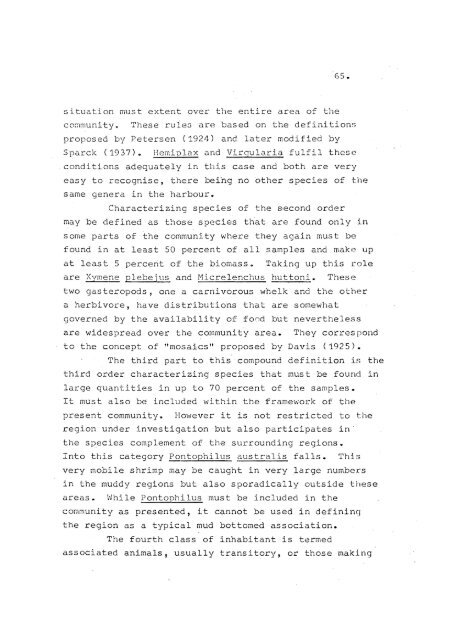The benthic ecology and community structure in Lyttelton Harbour ...
The benthic ecology and community structure in Lyttelton Harbour ...
The benthic ecology and community structure in Lyttelton Harbour ...
Create successful ePaper yourself
Turn your PDF publications into a flip-book with our unique Google optimized e-Paper software.
65.<br />
situation must extent over the entire area of the<br />
<strong>community</strong>. <strong>The</strong>se ru1es are based on the def<strong>in</strong>i ons<br />
proposed by Petersen (1924) <strong>and</strong> later modified by<br />
Sparck (1937). Hemiplax <strong>and</strong> Virgularia fulfil these<br />
. conditions adequately <strong>in</strong> this case <strong>and</strong> both are very<br />
easy to recognise, there be<strong>in</strong>g no 'other species of the<br />
same genera <strong>in</strong> the harbour.<br />
Characteriz<strong>in</strong>g species of the second order<br />
may be def<strong>in</strong>ed as those species t~at are found only <strong>in</strong><br />
some parts of the <strong>community</strong> where they aga<strong>in</strong> must be<br />
found <strong>in</strong> at least 50 percent of all samples <strong>and</strong> make up<br />
at least 5 percent of the biomasso Tak<strong>in</strong>g up this role<br />
are ~~ plebe jus <strong>and</strong> Micrelenchus huttoni.. <strong>The</strong>se<br />
two gasteropods, one a carnivorous whelk <strong>and</strong> the other<br />
a herbivore, ve distributions that are somewhat<br />
governed by the availability of fond but nevertheless<br />
are widespread over the <strong>community</strong> area. <strong>The</strong>y correspond<br />
to the concept of nmosaics" proposed by Davis (1925).<br />
<strong>The</strong> third part to this compound def<strong>in</strong>ition is the<br />
third order characteriz<strong>in</strong>g species that must be found <strong>in</strong><br />
large quantities <strong>in</strong> up to 70 percent of the samples.<br />
It must also be <strong>in</strong>cluded with<strong>in</strong> the framework of the<br />
present <strong>community</strong>.. However it is not restricted to the<br />
region under <strong>in</strong>vestigation but also participates <strong>in</strong><br />
the species complement of the surround<strong>in</strong>g regions.<br />
Into this category Pontophilu5 australis falls. This<br />
very mobile shrimp may be caught <strong>in</strong> very large numbers<br />
<strong>in</strong> the muddy regions but also sporadically outside these<br />
areas. While Pontophilus must be <strong>in</strong>cluded <strong>in</strong> the<br />
<strong>community</strong> as presented, it cannot be used <strong>in</strong> def<strong>in</strong><strong>in</strong>g<br />
the region as a typical mud bottomed association.<br />
<strong>The</strong> fourth class of <strong>in</strong>habitant is termed<br />
associated animals, usually transitory, or those mak<strong>in</strong>g
















